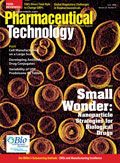PDA Takes On Risks for Patients
Risk management, and its benefits for patients, plays a big role at the PDA Annual Meeting.
The 2008 PDA Annual Meeting in Colorado Springs was a good example of how the organization has grown. As Ted Meltzer, a long-time friend and renowned professional, told me: "The PDA organization is now a powerhouse in processing information for the industry."

Maribel Rios
Consider, for example, how PDA has adopted risk management. Risk management used to be an abstract phrase no one really could define. This is no longer the case. Presenters discussed how risk management serves as a basis for process validation, the optimization of aseptic operations (e.g. Technical Report 44), and as an essential part of patient safety.
Will risk management principles continue to grow with PDA? "I hope so, as it might also have an influence on postapproval changes," says Maik Jornitz, chair of the 2008 planning committee. "[With a] risk-based approach on postapproval changes, maybe life could be a bit easier for innovative biopharmaceutical firms that want to introduce new production equipment into their processes. Former FDA Commissioner McClellan wished for a process improvement rate in biopharmaceutical processes similar to those in the semiconductor industry. This can only happen when regulatory authorities create the possibility for such requests. Maybe a risk-based approach would create such possibility."
Next year's meeting, which will focus on the impact of microchip technology, will expand on risk-management principles. According to Ian Elvins, chair of the 2009 planning committee, "The intention is to look at some of the many tools and techniques involving computers and automation, so clearly the adoption of a risk-based approach opens up many new possibilities that might not have been considered in the past. Not least will be techniques which use computers to directly evaluate risk to enable better decision-making."
Maribel Rios is a senior editor of Pharmaceutical Technology, mrios@advanstar.com
